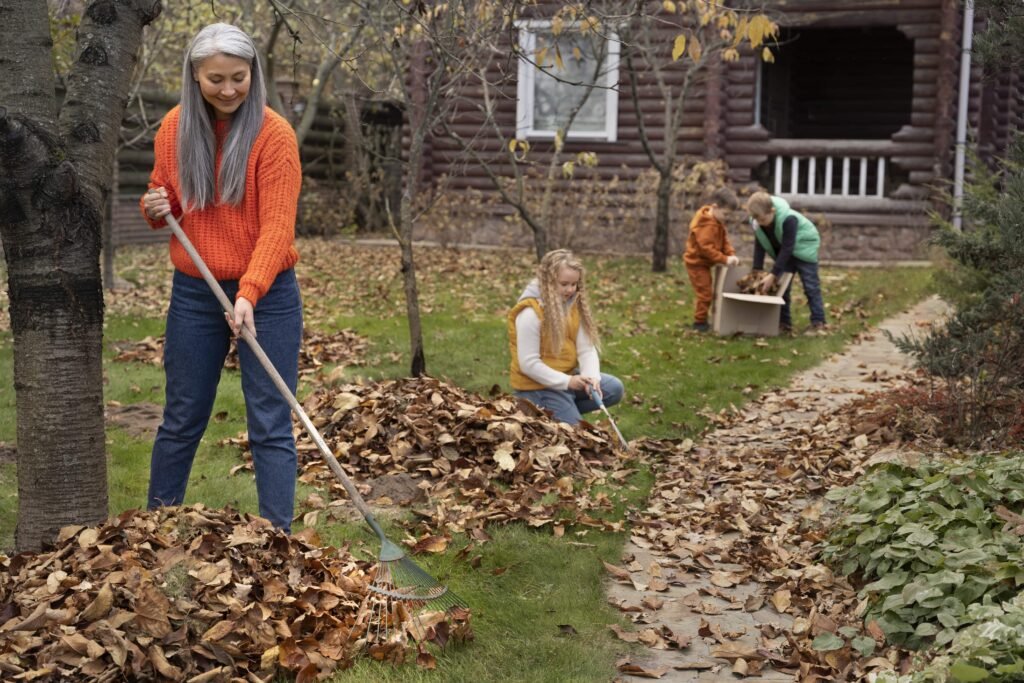Top 10 Spring Lawn Care Tips for a Lush Green Yard
Spring is here, and everything outside is starting to grow beautifully. Your lawn might need a little help to look as lively as everything else. Now is the perfect time to take care of your yard, making sure it turns into a lush, green space as the weather gets warmer. Taking good care of your lawn in spring helps it stay healthy all year, but it can be tricky to know how to begin. That’s why we’ve created these top ten spring lawn care tips to help you grow a yard that’s not just getting by, but truly flourishing.
These tips start with the basics of lawn care and move up to expert methods that professional landscapers recommend. They aim to improve both the health and look of your lawn. Whether you’ve been gardening for years or are a new homeowner ready to start taking care of your lawn, these tips are easy to follow and work. They’ll show you how to aerate your soil, pick the best fertilizers, and mow your lawn properly to make sure every grass blade looks its best. So, put on your gardening gloves, and let’s get set to make your yard the best-looking one around!
1- Check the Soil
Lawn care practices should not kick off until you are fully aware of the state of your soil, for everything else happens on top of it. Springtime is the best time when it comes to testing the soil, which gives you the level of pH and the nutrients possibly prevailing in that soil. Such information is vital as it informs whichever type of fertilizer one needs, and whether the soil acidity or alkalinity needs adjustment.
A soil-testing kit is easily found at your local garden center or cooperative extension service. Once you have your sample of soil, all you have to do is follow the instructions that come with the kit to get the best possible reading. If the test shows your soil is very low, that means your soil is acidic, and you can balance the two by applying lime to your soil. If the soil is very high, meaning it is alkaline, you might have to balance it with the addition of sulfur to the soil. Balanced soil portrays a better chance of supporting healthy grass, as it increases the nutrient availability of the soil.
Your soil test will also assess, besides the pH, macronutrients such as nitrogen, phosphorus, and potassium, which are essential elements for general plant growth. Based on the findings, you will have to adjust the method of fertilization to make good the deficiency. Good soil not only means a healthy lawn but also ensures your grasses are less vulnerable to pests diseases and various environmental stresses.
2- Buy the Right Grass
The best choice in terms of grass seed would be the kind that will ensure a rich turf that is packed with life. Unfortunately, not all grass species are appropriate for the climate and soil conditions that prevail, so it is only ideal to take one that is adequate for the particular location you are in and the condition of your yard. Specifically, Kentucky bluegrass, fescue, and ryegrass are considered cool-season grasses and will do the best job in the northern regions; Bermuda, Zoysia, and St. Augustine are some of the warm-season grasses that do best in the south.
Consider how much sunlight your grass will get when deciding which seed to purchase. Many grasses do best in full sun. Others can take some shade; in fact, some grasses will perform well in full or nearly full shade. Also, consider how much foot traffic your lawn is.
If you are not one hundred percent sure which particular kind of grass to choose, then consult with your local garden center or a lawn care expert. Based on your local climate and soil conditions, they can advise you. Dollars spent up front on the right bag of grass seed will pay dividends with regards to your lawn’s looks and health, and will save you work later on.
3- Weed Control
It is very important that in spring, maintaining a healthy and thick lawn, you keep your weeds under control. Weeds not only make your garden unsightly but also compete with grass for necessary nutrients, water, and light. It is always commendable to control weeds early in your lawns.
First, identify the kind of weeds in the garden. For example, common lawn weeds can include dandelions, crabgrass, clover, etc. Each kind may need a different approach for effective control. For example, pre-emergent herbicides work best on crabgrass, and these should be applied in early spring before the germination of weeds. For perennial weeds like dandelions, post-emergent herbicides are required, and these should be applied when the weeds are actively growing.
It is good sound, healthy grass that will form the best natural defense against the impending weed. Thick and vigorous turfs can choke out weeds by blocking off light necessary for weed growth. Regular mowing, watering, and application of fertilizer are the cornerstones in the maintenance of good turf conditions. Where the infestation is not so severe, hand pulling of the weed or the use of some tool is advisable. This way, it will be friendly for the environment by maintaining the lawn in a healthy and beautiful state.
4- Pest Control
Part of the spring lawn care is dealing with a pest that can ruin your grass. Early detection and treatment can make all the difference in keeping this very small invader from causing a huge amount of damage. Included in the common lawn pests are grubs, armyworms, chinch bugs, and sod webworms, each capable of turning a lush green yard into a patchy brown eyesore if not controlled.
You are first supposed to be certain of the kind of pests that you are in a position to handle. This is achieved with either a close visual inspection of the pests themselves or with traps that attract the pests for easy identification. Once you are sure of the problem, select an appropriate treatment technique. This can range from biological controls such as introducing beneficial nematodes, which naturally kill grubs, to chemical treatments like insecticides.
As with any pesticide application, read and follow all label directions to ensure the security of the grass as well as the surrounding environment. Be sure to time applications correctly; some products are more effective when the insects are in their larval form. Also, a good, healthy, overall turf from proper mowing, irrigation, and fertilization practices will assist in naturally improving the overall resistance that your turf may have to these pests. A healthy turf is less susceptible, thus less attractive, to pests and will help establish a lawn that will thrive long into spring and beyond.
5- Clearing Debris
So, be it spring cleaning, or something that you would undertake normally to keep the interiors in good shape, even your turf requires proper cleaning techniques. Though not so often, the majority of debris including leaves, twigs, and even trash tends to collect in your yard throughout winter. This hinders the growth of grass because it limits the entry of sunlight and air to the soil surface. Early spring is the best time to clear your lawn of this debris so that it will be prepared for one season of vigorous growth.
Begin by cleaning your lawn; remove the leaves, sticks, and other organic material you might find on its surface. This will not only clean your yard but will also loosen the soil slightly, allowing better air circulation and water penetration. The next thing you want to focus on is any thatch build-up; this is a thin layer of dead grass and roots on the surface of the soil. If thicker than half an inch, this is bad for your lawn’s health. Aerating can help by dethatching, which can be done by hand with a rake or through a power dethatcher for larger areas.
Other chores may lead you to the ground to pick things up by hand, such as branches that fell due to winter storms. With the lawn clear, it becomes easy to notice the condition of the grass and be in a good place for other chores such as seeding, fertilizing, and mowing. A clean lawn, free from debris, makes room for the green space to be healthy and green throughout the whole period of growing.
6- Aeration

Aeration is one of the most important steps in spring lawn care, especially when your lawn receives heavy traffic or the soil is compacted. Compaction limits the free movement of air, water, and nutrients in the soil, leading to poor growth and the appearance of grass. Aerating your lawn involves poking a bunch of little holes in your soil. This helps reduce compaction and increases the efficiency of watering and fertilizing.
The best form of aeration is core-type aeration, where plugs of soil are removed from the yard. Far superior to spike-type aeration, which just pushes soil aside, in some cases, spike-type aeration can increase compaction around the puncture. The best time to aerate is during the spring when the soil is moist and the grass is at its peak growth phase. That would allow the lawn to recover quickly and fully exploit the benefits of aeration.
This is a perfect moment to top-dress your lawn after aeration. Fertilizing: because of aeration, products go straight into the ground due to the holes punched. This will in time boost root growth and overall lawn vigor. Aeration allows better drainage for the lawn, not so much water pooling, and increases microbial activity in the soil, making the turf more hardy and healthy.
7- Seeding and Overseeding
Spring is a good time for seeding new lawns or overseeding old ones that are not thick enough with a good turf stand. Seeding means planting new grass for a new lawn or filling in areas of a thin lawn. Overseeding is when you place new grass seed in an existing lawn; it increases the lawn’s density, health, and appearance.
When establishing a new lawn or reseeding bare areas, it is important to select the right mix of grass seeds for a particular region, climate, and the specific yard conditions as described above. Prepare the soil by raking off debris on the surface and loosening the top inch or two. This allows for seed-to-soil contact, which is critical. Apply the seed uniformly with the spreader. Rake in the seed lightly to enhance seed-to-soil contact. Lightly and regularly water newly seeded areas so that the seed will not dry up but new grass will become established quickly.
For overseeding, mow your existing lawn to a short height before you start, and bag the clippings to ensure the seed contacts the soil. If your lawn is compacted or full of thatch, do core aeration to improve soil health before overseeding. You might also want to apply a light layer of soil or compost over the seeds to protect them from birds and prevent drying out. Regular watering and avoiding heavy foot traffic on the new seeds are crucial until the grass is well established. This renovation practice will thicken the lawn, making it more lush and durable, ready for the summer.
8- Fertilization
Fertilizing is the keystone to proper spring lawn care. It provides the grass with the required nutrients, and when the grass is coming out of the winter dormant stage, a well-timed application can stimulate growth, improve green color, and help in rooting. Proper selection of the kind of fertilizer and proper timing of application are key to attaining good health benefits with the least environmental impact.
As mentioned earlier, soil testing may provide the precise nutrients lacking in your lawn. Generally speaking, a balanced fertilizer containing nitrogen, phosphorus, and potassium is good for most lawns. Nitrogen is more important in the spring for leaf growth, hence that nice green color of your lawn. Be careful not to apply too much since this will cause your lawn to grow fast and be more susceptible to diseases and a little less drought-resistant.
The timing of fertilizer applications is important. A good rule of thumb is to fertilize a developed lawn at soil temperatures of around 55°F when grass starts active growth. Using a slow-release fertilizer puts fewer chemicals at a time but a larger amount over a few weeks, allowing for steady growth without the risk of runoff. Make sure you follow the manufacturer’s recommendations and use a spreader to ensure even distribution. Regular fertilizer applications keep your lawn healthy, less prone to pests and diseases, and more resistant to weed invasions.
9- Watering Wisely
Good watering practices go a long way in achieving a healthy and verdant lawn, from the spring to the peak of summer. A deep and infrequent rhythm is the best way to water, as it encourages deep roots that help the lawn withstand drought.
Watering too lightly and too frequently often results in shallow-rooted lawns that have poor drought tolerance. Shallow-rooted grass means weak grass. Generally, your lawn needs about one to one-and-a-half inches of water a week from rain or irrigation. This amount can be adjusted depending on your soil type, climate, and grass species. Sandy soils drain quickly and need more frequent watering, while clay soils retain moisture longer and need less frequent watering.
The best time to water your lawn is early in the morning. This reduces evaporation and allows water to soak deeply into the soil before temperatures rise. Avoid watering at night because the grass will stay wet all night, which can encourage fungal diseases.
If you use a sprinkler system, make sure it’s properly calibrated to avoid over- or under-watering different parts of your lawn. Consider a smart irrigation controller that adjusts watering based on weather conditions, soil moisture, and plant water use. This makes your watering routine more efficient and tailored to your lawn’s specific needs.
10- Lawn Equipment Maintenance
Proper care and maintenance of your lawn equipment will ensure effective and efficient care and maintenance of your lawn. Good tools can make a big difference in the overall health and look of the lawn. Proper servicing of your mowers, trimmers, and other garden tools before springtime will reward you in the long run.
The first place to start is really by giving your lawnmower a good checkup. Change the oil, replace the spark plug, and be sure the air filter is clean. It is particularly pertinent to sharpen the mower blades. Dull blades tear the grass rather than make a neat cut. Besides, the cuts must be clean; otherwise, they will leave your lawn raggedly, making your grass more exposed to diseases. A clean, sharp cut is imperative in maintaining lawn health.
Check for wear and damage on shears, trimmers, leaf blowers, and other tools. Lubricate their moving parts as needed, paying special attention to any screws and bolts that may be loose. Hose reels and sprinklers should be free of any blockages and dirt to work correctly.
Finally, think of storage for your equipment. Keeping your implements clean, dry, and stored properly when not in use will help to extend your tools’ life and performance. Regular maintenance not only keeps your lawn care routine running smoothly but also avoids frustration through equipment failure during critical times of lawn care. You will have a successful gardening season if you do this.
In Conclusion
With all the right spring lawn care practices, you could have the most eager, green lawn. With good soil knowledge, the right choice of grass seeds, and the right techniques for weed and pest management, you are on the road to a healthy lawn. Regular tasks, including removing debris, aeration, seeding, and fertilizing, ensure that your grass receives the best conditions to become lively. Proper watering and detailed maintenance of your lawn equipment keep the general vivacity of your lawn high. With the top ten tips, you are on your way to a healthy, robust lawn that will make all your neighbors green with envy. Happy gardening!
FAQs
When should I start spring lawn care?
Start your spring lawn care as soon as the soil temperature reaches around 55 degrees Fahrenheit. This is typically when the grass begins to grow actively.
How often should I water my lawn in the spring?
Water your lawn deeply and infrequently, aiming for about 1 to 1.5 inches of water per week. Early morning is the best time to water to minimize evaporation and prevent fungal diseases.
What type of fertilizer should I use for my lawn in spring?
Use a balanced fertilizer that provides essential nutrients like nitrogen, phosphorus, and potassium. A soil test can help you determine the specific needs of your lawn.
How do I choose the right grass seed for my lawn?
Choose grass seed based on your climate and the specific conditions of your yard, such as sunlight exposure and soil type. Cool-season grasses are ideal for northern areas, while warm-season grasses thrive in southern regions.
Why is aeration important for my lawn?
Aeration helps relieve soil compaction, allowing air, water, and nutrients to reach the roots more effectively. This promotes healthier, deeper root growth and improves overall lawn health.







